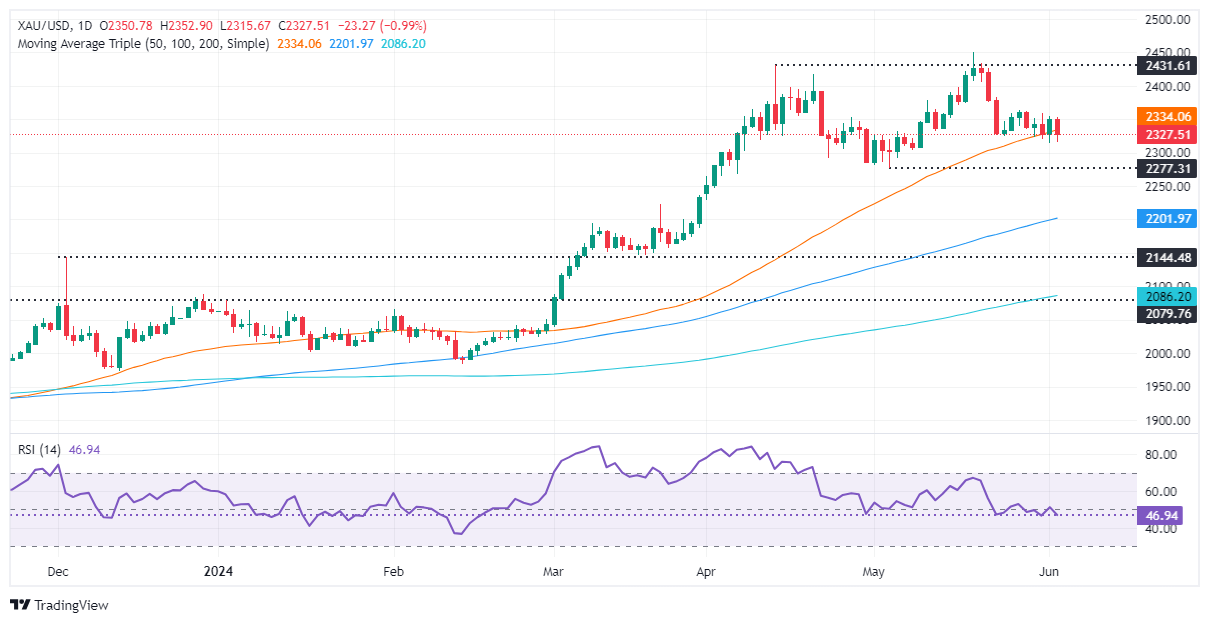- Gold drops 0.90% as commodities face widespread pressure.
- US Treasury yields fall seven basis points, but the Greenback gains marginally, with the DXY up 0.04% to 104.08.
- US JOLTS data hit three-year low, showing economic slowdown alongside below-estimate Durable Goods Orders.
Gold prices retreat some 0.90% in the mid-North American session on Tuesday, amid a risk-off impulse and despite falling US Treasury bond yields. The latest tranche of US economic data shows the economy is slowing down, warranting lower interest rates. Despite that, the XAU/USD trades with losses and exchanges hands at $2328.
The golden metal has fallen below $2350 a troy ounce as commodities plunges across the board. Oil prices were under heavy pressure earlier amidst fears that the global economy might grow at a slower pace, which could dent demand for crude.
US Treasury yields, which usually correlate inversely to Gold prices, were also down seven basis points, as depicted by the US 10-year T-note yield.
Contrarily, the Greenback is trading with marginal gains of 0.04%, as depicted by the US Dollar Index (DXY). The DXY tracks the greenback against a basket of six currencies and is up at 104.08.
Data-wise, the US economic docket featured the release of April’s JOLTS data and Durable Goods Orders. The reports showcased that the economy remains resilient yet weak amid higher borrowing costs set by the US Federal Reserve.
Following the data release, the December 2024 fed funds rate futures contract showed that most traders expect at least 36 basis points of rate cuts via the Chicago Board of Trade (CBOT).
Consequently, US Treasury bond yields dropped, and the Greenback extended its losses to three straight days. The US 10-year Treasury bond yields plunged eleven basis points to 4.392%. The US Dollar Index (DXY), which tracks the performance against a basket of six currencies, fell 0.5% to 104.07.
Daily Digest Market Movers: Gold price falls as US Treasury yields retreat
- Tuesday’s US economic docket featured the US JOLTs Job Openings report, which decreased from 8.355 million to 8.059 million in April, falling short of the estimated 8.34 million.
- US Durable Goods Orders rose by 0.6% month-over-month in April, which is below both the estimates and the previous reading of 0.7%.
- Last week, the US Core Personal Consumption Expenditure Price Index (PCE), the Fed’s preferred inflation gauge, stabilized, boosting hopes for potential rate cuts.
- Meanwhile, business activity showed mixed results, with the S&P Global Manufacturing PMI expanding, while the Institute for Supply Management (ISM) Manufacturing PMI contracted for the second consecutive month.
- Traders are currently pricing about a 54.9% chance of a rate cut, according to the CME FedWatch Tool.
- The US economic docket during the week will feature ADP Employment Change ahead of Friday’s Nonfarm Payrolls.
Technical analysis: Gold price slips below $2,350
Gold’s rally remains in place, though the spot prices have fallen below the 50-day Simple Moving Average (SMA) of $2,334. Price action and the momentum shifted in favor of the sellers could pave the way for a pullback. The Relative Strength Index (RSI) turned bearish, below the 50 midline, opening the door for further Gold’s losses.
Once the XAU/USD fell below the 50-day Simple Moving Average (SMA) at $2,334, that could pave the way to challenge the May 8 low of $2,303, followed by the May 3 cycle low of $2,277.
Further gains lie ahead if XAU/USD buyers reclaim $2,350. Up next would be the $2,400 level, followed by the year-to-date high of $2,450 and, subsequently, the $2,500 mark.
Fed FAQs
Monetary policy in the US is shaped by the Federal Reserve (Fed). The Fed has two mandates: to achieve price stability and foster full employment. Its primary tool to achieve these goals is by adjusting interest rates. When prices are rising too quickly and inflation is above the Fed’s 2% target, it raises interest rates, increasing borrowing costs throughout the economy. This results in a stronger US Dollar (USD) as it makes the US a more attractive place for international investors to park their money. When inflation falls below 2% or the Unemployment Rate is too high, the Fed may lower interest rates to encourage borrowing, which weighs on the Greenback.
The Federal Reserve (Fed) holds eight policy meetings a year, where the Federal Open Market Committee (FOMC) assesses economic conditions and makes monetary policy decisions. The FOMC is attended by twelve Fed officials – the seven members of the Board of Governors, the president of the Federal Reserve Bank of New York, and four of the remaining eleven regional Reserve Bank presidents, who serve one-year terms on a rotating basis.
In extreme situations, the Federal Reserve may resort to a policy named Quantitative Easing (QE). QE is the process by which the Fed substantially increases the flow of credit in a stuck financial system. It is a non-standard policy measure used during crises or when inflation is extremely low. It was the Fed’s weapon of choice during the Great Financial Crisis in 2008. It involves the Fed printing more Dollars and using them to buy high grade bonds from financial institutions. QE usually weakens the US Dollar.
Quantitative tightening (QT) is the reverse process of QE, whereby the Federal Reserve stops buying bonds from financial institutions and does not reinvest the principal from the bonds it holds maturing, to purchase new bonds. It is usually positive for the value of the US Dollar.

